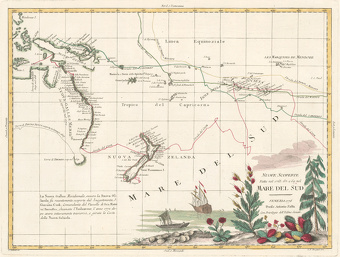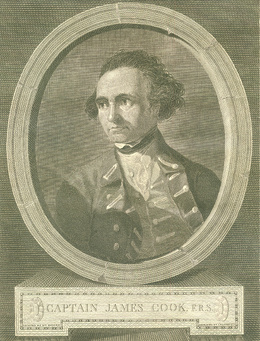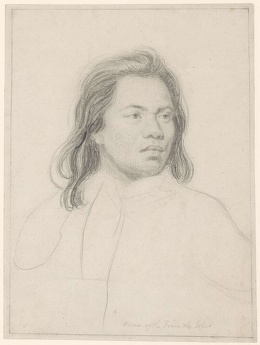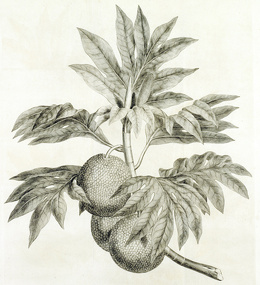Home | Category: History and Exploration
COOK IN THE PACIFIC
Captain James Cook (1728-1779) became the first European to have extensive contact with various people of the Pacific. He correctly postulated a link among all the Pacific peoples, despite their being separated by great ocean stretches.. Cook theorized that Polynesians originated from Asia, which scientists have since verified.
Cook's 12 years sailing around the Pacific Ocean, in three voyages (1768–1771, 1772–1775 and 1776–1779), contributed much to Europeans' knowledge of the area. Several islands, such as the Hawaiian group, were encountered for the first time by Europeans. Cook learned about the periodic but predictable winds that may have helped Polynesian mariners settle the Pacific.
Terence E. Hays wrote in the “Encyclopedia of World Cultures”: “The list of islands and island groups 'discovered" or "rediscovered" by Cook is long, induding the Hawaiian group, Christmas Island, New Caledonia, the Cook Islands, the Gilbert Islands, Fiji, Tonga, the Solomon Islands, Easter Island, and part of the Tuamotu Archipelago. In addition, his carefully drawn charts proved finally that New Guinea, New Zealand, and Australia were not joined together, as many had supposed. Cook's accomplishments, including a vast quantity of scientific specimens and observations, have never been equaled, in the Pacific or elsewhere in the world. By the conclusion of Cook's voyages, the main outlines of the island groups of Oceania were charted, and only locally systematic exploration would be undertaken in the future. From the Europeans' point of view, now was the time for exploitation of the resources and people of this vast new realm. |~|
Cook's effort to bring a Polynesian to England ended when Tupaia, a Tahitian prince, died on route. Cook later introduced a handsome Tahitian named Omai to polite society. In addition to collecting and describing plants new to the West, Joseph Banks, the gentleman-scientist on Cook’s also introduced plants to Tahiti. "I employed myself in planting a large quantity of the seeds of Watermelons, Oranges, Lemons, limes...which I brought from Rio de Janeiro."
Related Articles:
CAPTAIN JAMES COOK: HIS LIFE, CAREER, DEATH AND CONTRIBUTIONS ioa.factsanddetails.com ;
VOYAGES OF CAPTAIN JAMES COOK: SHIPS, CREW, MISSIONS, DISCOVERIES ioa.factsanddetails.com ;
CAPTAIN JAMES COOK IN NEW ZEALAND AND AUSTRALIA ioa.factsanddetails.com
DISCOVERY OF AUSTRALIA AND NEW ZEALAND BY EUROPEANS ioa.factsanddetails.com
SPICES, TRADE AND THE SPICE ISLANDS factsanddetails.com ;
EUROPEANS DISCOVER THE PACIFIC AND OCEANIA ioa.factsanddetails.com ;
MAGELLAN AND THE FIRST VOYAGE AROUND THE WORLD ioa.factsanddetails.com ;
FIRST EUROPEAN IN NEW ZEALAND: EXPLORERS, SETTLERS AND THEIR IMPACT ON THE MAORI ioa.factsanddetails.com
EUROPEANS IN THE PACIFIC IN THE 1800S: WHALERS, MISSIONARIES, COPRA AND FORCED LABOR ioa.factsanddetails.com
Pacific Stops During the First Voyage of Captain Cook (1768–1771)
Cook's first expedition in 1768-1771 began in England on September 1768 and included stops in Tahiti (beginning March 1769), New Zealand (beginning October 1769) and Australia (beginning January 1770).
Terence E. Hays wrote in the “Encyclopedia of World Cultures”: “Cook's first voyage was undertaken primarily for scientific knowledge (although British colonial ambitions were a significant factor as well). He was commissioned to observe the transit of Venus before the sun, with Tahiti identified as the best location for the necessary astronomical measurements, and to find Terra Australis. He returned with detailed charts and new information regarding Tahiti and New Zealand, as well as other islands, but no news of a southern continent. [Source: “Encyclopedia of World Cultures, Volume 2: Oceania,” edited by Terence E. Hays, 1991 |~|]
In May 1768, the Admiralty commissioned Cook to command a scientific voyage to the Pacific Ocean. Cook was age 39 at the time. On June 3, 1769 the planet Venus crossed the path of the sun, an event that only happens once a century. By calculating when this moment occurred from different points around the world the distance from the earth to the sun could be calculated. One of the reason's for Captain Cook's first expedition was to make Venus calculations from Tahiti.
Cook and his crew rounded Cape Horn at the bottom of South America and continued westward across the Pacific, arriving at Tahiti, where the observations of the transit were made. However, the result of the observations was not as conclusive or accurate as had been hoped. Once the observations were completed, Cook opened the sealed orders, which were additional instructions from the Admiralty for the second part of his voyage: to search the south Pacific for signs of the postulated rich southern continent of Terra Australis. [Source: Wikipedia]
Pacific Stops During the Second Voyage of Captain Cook (1772–1775)
Cook's second voyage was over three years long — from July 1772 to July 1775. The purpose was to look for the rumored southern continent. He covered almost the whole of the Pacific, including islands off the coast of Antarctica, and established that Australia was large, but not the continent that had been imagined, and that Terra Australis was only imaginary.
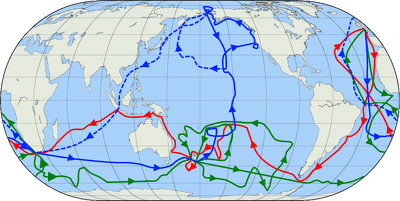
Three voyages of Captain James Cook, with the first in red, second in green, and third in blue; the route of Cook's crew following his death is indicated with dashed blue line
In January 1773, in the Antarctic fog, Resolution and Adventure, the two ships involved in in the Cook’s second voyage became separated. Adventure made its way to New Zealand, where it lost some men during an encounter with Māori, and eventually sailed back to Britain, while Cook continued to explore the Antarctic, reaching 71°10'S.
Cook almost encountered the mainland of Antarctica but turned towards Tahiti to resupply his ship. He then resumed his southward course in a second fruitless attempt to find the supposed continent. On this leg of the voyage, he brought a young Tahitian named Omai, who proved to be somewhat less knowledgeable about the Pacific than Tupaia, another tahitian, had been on the first voyage. On his return voyage to New Zealand in 1774, Cook landed at the Friendly Islands, Easter Island, Norfolk Island, New Caledonia, and Vanuatu. Cook's second expedition included William Hodges, who produced notable landscape paintings of Tahiti, Easter Island, and other locations.
Pacific Stops During the Third Voyage of Captain Cook (1776–1779)
The purpose of Cook’s third voyage was to the fabled Northwest Passage between the Pacific and Atlantic Oceans north of Canada. Cook ventured to the Pacific once again, this time hoping to travel east to the Atlantic, while another expedition traveled from Atlantic to the Pacific. During this trip rip Cook was killed in Hawaii. The third voyage, which was completed after Cook's death, lasted four years and three months — from July 1776 to October 1780 — was one of the longest voyages of discovery in history. [Source: "The Voyages of Captain Cook" by Alam Villiers, September 1971]
After dropping Omai at Tahiti, Cook travelled north and in 1778 became the first European to begin formal contact with the Hawaiian Islands. After his initial landfall in January 1778 at Waimea harbour, Kauai, Cook named the archipelago the "Sandwich Islands" after his friend and patron, the fourth Earl of Sandwich.
From the Sandwich Islands, Cook sailed north and then northeast to explore the west coast of North America north of the Spanish settlements in Alta California. He sighted the Oregon coast and spent some time in the Nootka Sound off Vancouver Island, trading with local ethnic groups. After leaving Nootka Sound in search of the Northwest Passage, Cook explored and mapped the coast all the way to the Bering Strait, charting the majority of the North American northwest coastline on world maps for the first time, determining the extent of Alaska, and exploring the region between in Russian control to west and Spanish control to the south.
By August 1778, Cook had sailed through the Bering Strait into the Chukchi Sea off of northeast Russia.. He headed northeast up the coast of Alaska until he was blocked by sea ice at a latitude of 70°44 north. Cook then sailed west to the Russian Far East coast, and then southeast down the Russian coast back to the Bering Strait. By early September 1778 he was back in the Bering Sea to begin the trip to the Sandwich (Hawaiian) Islands. At this time he was frustrated that he couldn’t find the Northeast Passage and began to suffer from a stomach ailment. Some have suggested that his illness and mental state led to irrational behavior towards his crew, such as forcing them to eat walrus meat, which they had said was inedible.
Cook and His Crew on Tahiti
In August 1769, during Cook’s first voyage, Sydney Parkinson and Joseph Banks went to see the entertainment called a Heivo: Parkinson wrote: “A large mat was laid upon the ground, and they began to dance upon it, putting their bodies into strange motions, writhing their mouths, and shaking their tails, which made the numerous plaits that hung about them flutter like a peacock’s train. Sometimes they stood in a row one behind the other, and then they fell down with their faces to the ground, leaning on their arms, and shaking only their tails, the drums beating all the while, with which they kept exact time.” [Source: Parkinson 1773, 74]
Describing Cook’s arrival in Tahiti at the Harbor of Annamooka during his third voage, David Samwell wrote: “Capt Cook went on shore in the Bay & fixed upon a House which he hired of the Indians for our Use during our Stay….& a Market was established before the House…where those who had any thing for market exposed them to sale.” [Source: Journals III, 2, 1013]
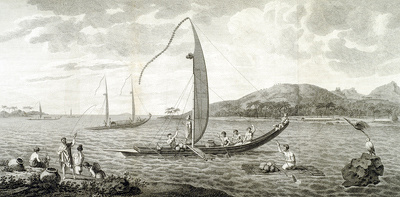
Matavai Bay (Tahiti) and Tahitian Boats (Hawkesworth, vol 2, plate 4)
Walking in Tahiti in September 1777, during the third voyage, members of the crew came across, Cook wrote: “a kind of private Heeva or amusement, which consisted of about a hundred of the inhabitants of the neighbourhood who wer(e) sitting in a house and in the midst of them two women with an old man behind, each beating very gently upon a drum, and the women at intervals singing in a softer manner than I ever heard at their other diversions. The assembly listened with great attention and were seemingly almost absorbed in the pleasure the music gave them, as few took any notice of us and the performers never once stop’d.” [Source: Cook, Journals III, 2, 985)
Cook on Ceremonies for the Dead and Cannibalism Tahiti
During the first voyage, Cook wrote: “There is a ceremony which they perform at or after the funerals of the dead…relations dress’d himself in a very odd dress…with Plumes of feathers something in the same manner as those worn by Coaches hearses, horses & ca. at the funerals in London; it was very neatly made up of black or brown and white cloth black and white feathers and pearl oysteres shells…and not only looked grand but awfull likewise. The man thus equip’d and attended by two or three more men or women…would about sunset take a compass of near a mile runing here and there, and where ever they came the people would fly from them as tho they had been so many hobgoblins not one daring to come in their way. I know not the reason for their performing this ceremony which they call Heiva.” [Source: Cook, Journals I, p.135-6, July 1769]
Cook recorded this scene in Tahiti in August 1777 during the third voyage, “Some of our gentlemen in their walks found what they were pleased to call a Roman C(at)holic Chappel…it proved to be a Tupapow in which the remains of the late Waheatua laid as it were in state. It was a pretty large neat house which was inclosed with a low palisade…it was covered and hung round with different Coloured cloth and Mats so as to have a pretty affect…Small offerings of fruit &c seemed to be daily made.” [Source: Cook, Journals III, I, 190-1]
Cook and some of his crew witnessed this ceremony that took place over two days in September 1777, during the third voyage in Tahiti. It was described in great detail by William Anderson: “On certain occasions but particularly on going to war, as in the instance we saw, and in times of great scarcity which sometimes happens here, the priest pretends to consult their god and asks his assistance…and (says) that it is necessary to sacrifice a man on the occasion…having determined on the man he is by their order suddenly put to death either with a club or by stoning…We could not see the Body, as it was fastened lengthways to a sort of pole with some Cocoa leaves over it but they uncover’d it after the priest had repeated some sentences for ten minutes…The Priest sat at a small distance from the feet…he seemed often to expostulate with the dead person, to whom he constantly address’d himself and sometimes ask’d several questions seemingly with respect to the propriety of his being killd…he askd him to deliver Morea, its chief who is namd Maheine, the hogs, women and other things of the island into their hands, which indeed was the express intention of the sacrifice…a hole was dug by two men about two feet deep, when they threw in the body with an air of great indifference and coverd it over with earth and stones.” [Source: Cook, Journals III, 2, 978-84]
Cook and His Crew on Tattoos in Tahiti
Cook first came across tattooing in Tahiti and found that many in the Pacific islands and New Zealand decorated themselves with tattoos. Some of the crew on Cook’s first voyage decided to get tattoos. It has been suggested that this was the beginning of the tradition of sailors getting the tattooed. One of the first included Robert Stainsby, aged 27, an able seaman originally from Darlington in the North East of England: Sydney Parkinson wrote: "Mr Stainsby, myself, and some others of our company, underwent the operation, and had our arms marked.” [Source: Sydney Parkinson’s Journal, 13th July 1769]
Cook himself described the process of tattooing in Tahiti: “Both sexes paint their bodys Tattow as it is called in their language, this is done by inlaying the Colour of black under their skins in such a manner as to be indelible. Their method of Tattowing I shall now describe. The coulour they use is lamp black prepared from the smook of a kind of Oily nutt (the candlenut) used by them instead of Candles. [Source: Cook, Journals I, p.125, July 1769)]
“The Instruments for pricking it under the skin is made of very thin flat pieces of bone or shell…one end is cut into sharp teeth and the other fasten’d to a handle; the teeth are diped into the black liquor and then drove by quick sharp blows struck upon the handle with a stick for that purpose into the skin so deep that every stroke is followed (with) a small quantity of blood, the part so marked remains sore for some days before it heals....As this is a painfull operation especially the tattowing their buttocks it is perform’d but once in their life time, it is never done until they are 12 or 14 years of age.” (Cook, Journals I, p.125, July 1769)
Cook in Tonga
Cook visited Tonga in 1773 and 1777 during his second and third voyages and gave the archipelago the name “the Friendly Islands” because of the gentle nature of the people he encountered. He was unaware that while he was there there was debate among chiefs and nobles over who should have the honor of attacking Cook's tiny fleet and killing its sailors. [Source: “Countries of the World and Their Leaders Yearbook 2009]
After visiting Tonga, Cook wrote in his log "the friendly behavior of the Natives who seem'd to [vie] with each other in doing what they thought would give us pleasure...this group I have named the Friendly Archipelago as a lasting friendship seems to subsists among the Inhabitants and their Courtesy to Strangers entitles then to that name." Cook returned for the last time in 1777. After leaving he wrote: "Thus we took leave of the Friendly Islands and their inhabitants after a stay of between two and three Months, during which time we lived together in the most cordial friendship..."
Samwell described the scene at Hapaee in Tonga: “A prodigious Number of the Natives were collected together on the Beach & a large Space was left clear for our People. Captn. Cook with some of the officers of each Ship sat in a House at the upper end of the open Area along with Phenow & the Chiefs of the Island.” [Source: Samwell in Cook, Journals III, 2, 1016-19]
Cook described the entertainment on his arrival at Hapaee: “Presently after a number of men entered the Circle or Area before us, armed with Clubs….and began to engage and continued till one or the other gave out or their weapons were broke….there were Wristling and Boxing matches; the first were performed in the same m(an)ner as at Otahiete, and the second very little different from the method practiced in England.” [Source: Cook, Journals, III, i, 107]
Cook in Hawaii
In 1778, Cook became the first European to begin formal contact with the Hawaiian Islands. After his initial landfall in January 1778 at Waimea harbour, Kauai, Cook named the archipelago the "Sandwich Islands" after the fourth Earl of Sandwich. The Hawaiians initially welcomed him warmly. [Source: Wikipedia]
After exploring Alaska, the Bering Strait and waters off northeast Russian, Cook returned to Hawaii in 1779. After sailing around the archipelago for some eight weeks, he made landfall at Kealakekua Bay on Hawai'i Island, largest island in the Hawaiian Archipelago.
Cook's arrival coincided with the Makahiki, a Hawaiian harvest festival of worship for the Polynesian god Lono. Coincidentally the form of Cook's ship, HMS Resolution, or more particularly the mast formation, sails and rigging, resembled certain significant artefacts that formed part of the season of worship. Similarly, Cook's clockwise route around the island of Hawaii before making landfall resembled the processions that took place in a clockwise direction around the island during the Lono festivals. It has been argued that such coincidences were the reasons for Cook's (and to a limited extent, his crew's) initial deification by some Hawaiians who treated Cook as an incarnation of Lono. The view that Hawaiians viewed Cook to be Lono is not agreed on by everyone.
On the masks worn by the Hawaiian men, James King wrote: “We never saw these masks worn but twice, and both times by a number of people together in a canoe, who came to the side of the ships laughing and drolling with an air of masquerading. Whether they may not likewise be used as a defence for the head against stone, for which they seem best designed, or in some of their public games, or be merely intended for the purpose of mummery, we could never inform ourselves.” [Source: Cook/King 1984 III, 139-40)]
Cook wrote in January 1778: “In the course of my several voyages I never before met with the natives of any place so much astonished, as these people were, upon entering a ship. Their eyes were continually flying from object to object; the wildness of their looks and gestures fully expressing their entire ignorance about everything they saw, and strongly marking to us, that, till now, they had never been visited by Europeans, nor been acquainted with any of our commodities except iron.”
Descriptions of Wave-Riding in Tahiti by Cook’s Crew
Cook is credited with "discovering" surfing. He never tried surfing and didn't even know how to swim but he reportedly witnessed it along with his crew, one of whom wrote: it "sends them in with astonishing Velocity..." One of the first written descriptions of wave riding appeared in a 1777 journal entry published "A Voyage to the Pacific Ocean," a three-volume book series published after Cook's death. Initially, historians believed that the famous passage had been written by Cook himself, but the first-person voice is misleading. It was actually written by Dr. William Anderson, the HMS Resolution's surgeon.[Source: SurferToday.com, July 3, 2020]
While the Resolution' was anchored at Matavai Bay in Tahiti, he walked along the bay and observed locals paddling their canoes and catching waves toward the shore. Her wrote: "I could not help concluding that this man felt the most supreme pleasure while he was driven on so fast and so smoothly by the sea; especially as, though the tents and ships were so near, he did not seem in the least to envy or even to take any notice of the crowds of his countrymen collected to view them as objects which were rare and curious. During my stay, two or three of the natives came up, who seemed to share his felicity, and always called out when there was an appearance of a favorable swell, as he sometimes missed it by his back being turned, and looking about for it.By then I understood that this exercise... was frequent among them; and they have probably more amusements of this sort which afford them at least as much pleasure as skating, which is the only of ours with whose effects I could compare it."
In 1769, Joseph Banks, a scientist on Cook’s first voyage, also wrote about Matavai Bay wave riders: "(...) the shore was covered with pebbles and large stones; yet, in the midst of these breakers, were ten or twelve Indians swimming for their amusement: whenever a surf broke near them, they dived under it, and, to all appearance with infinite facility, rose again on the other side... This diversion was greatly improved by the stern of an old canoe, which they happened to find upon the spot; they took this before them, and swam out with it as far as the outermost beach, then two or three of them getting into it, and turning the square end to the breaking wave, were driven in towards the shore with incredible rapidity, sometimes almost to the beach; but generally the wave broke over them before they got half way, in which case they dived, and rose on the other side with the canoe in their hands: they then swam out with it again, and were again driven back, just as our holiday youth climb the hill in Greenwich park for the pleasure of rolling down it...At this wonderful scene we stood gazing for more than half an hour, during which time none of the swimmers attempted to come on shore, but seemed to enjoy their sport in the highest degree; we then proceeded in our journey, and late in the evening got back to the fort."
Descriptions of Surfing in Hawaii by Cook’s Crew
In 1779, James King, a lieutenant in Cook’s crew, wrote a two-page journal entry on "board-riding” that he witnessed one afternoon spent on the beach at Kealakekua Bay, shortly before Cook's death: "The surf, which breaks on the coast round the bay, extends to the distance of about one hundred and fifty yards from the shore, within which space the surges of the sea, accumulating from the shallowness of the water, and dashed against the beach with prodigious violence.Whenever, from stormy weather, or any extraordinary swell at sea, the impetuosity of the surf is increased to its utmost height, they choose that time for this amusement, which is performed in the following manner: Twenty or thirty of the natives, taking each a long narrow board, rounded at the ends, set out together from the shore."
"The first wave they meet, they plunge under, and suffering it to roll over them, rise again beyond it, and make the best of their way... out into the sea. The second wave is encountered in the same manner with the first; the great difficulty consisting in seizing the proper moment of diving under it, which, if missed, the person is caught by the surf, and driven back again with great violence; and all his dexterity is then required to prevent himself from being dashed against the rocks. As soon as they have gained by these repeated efforts, the smooth water beyond the surf, they lay themselves at length on their board, and prepare for their return."
“As the surf consists of a number of waves, of which every third is remarked to be always much larger than the others... their first object is to place themselves on the summit of the largest surge, by which they are driven along with amazing rapidity toward the shore. If by mistake they should place themselves on one of the smaller waves, which breaks before they reach the land, or should not be able to keep their plank in a proper direction on the top of the swell, they are left exposed to the fury of the next, and, to avoid it, are obliged to dive and regain their place, from which they set out."
"Those who succeed in their object of reaching shore, have still the greatest danger to encounter. The coast being guarded by a chain of rocks, with, here and there, a small opening between them, they are obliged to steer their boards through one of these, or, in case of failure, to quit it, before they reach the rocks, and, plunging under the wave, make the best of their way back again.This is reckoned very disgraceful, and is also attended with the loss of the board, which I have often seen, with great horror, dashed to pieces, at the very moment the islander quitted it. The boldness and address with which we saw them perform these difficult and dangerous maneuvers, was altogether astonishing, and is scarcely to be credited."
Captain Cook’s Death in Hawaii
Cook was killed in Hawaii after being clubbed on the head and held under water and drowned by islanders in Hawaii after he got angry with them for stealing the nails that held his ship together. The incident happened in 1779, during Cook's third voyage in the Pacific, after tensions escalated between his men and the local people of Hawaii and Cook himself to attempted kidnap chief Kalaniʻōpuʻu, the King of Hawaii, on the shoreline of Kealakekua Bay, in Hawaii.
After a month's stay in Hawaii, Cook attempted to resume his exploration of the northern Pacific, but shortly after leaving Hawaii Island Resolution's foremast broke, so the ships returned to Hawaii for repairs. Tensions rose, and quarrels broke out between the Europeans and Hawaiians at Kealakekua Bay, including the theft of wood from a burial ground under Cook's orders. On February 13, 1779, an unknown group of Hawaiians stole one of Cook's longboats. Cook responded to the theft by attempting to kidnap and ransom Kalaniʻōpuʻu.
By then the Hawaiian people had become "insolent", according to Cook, even with threats to fire upon them. On February 14, 1779, Cook went ashore to the King's village and took him by his own hand and led him away. One of Kalaniʻōpuʻu's favorite wives, Kanekapolei, and two chiefs approached the group as they were heading to the boats. They pleaded with the king not to go. An old kahuna (priest), chanting rapidly while holding out a coconut, attempted to distract Cook and his men as a large crowd began to form at the shore. As Cook turned his back to help launch the boats, he was struck on the head by the villagers and then stabbed to death as he fell on his face in the surf.
See Captain Cook’s Death and Aftermath Under CAPTAIN JAMES COOK: HIS LIFE, CAREER, DEATH AND CONTRIBUTIONS ioa.factsanddetails.com
Image Sources: Wikimedia Commons
Text Sources: Source: National Geographic article by Alan Villiers; the book "The Discoverers" by Daniel Boorstin, “Encyclopedia of World Cultures, Volume 2: Oceania,” edited by Terence E. Hays, 1991, Wikipedia, New York Times, Washington Post, Los Angeles Times, Times of London, Lonely Planet Guides, Library of Congress, The Guardian, National Geographic, Smithsonian magazine, The New Yorker, Reuters, Associated Press, AFP, BBC, CNN, and various books, websites and other publications.
Last updated October 2025

